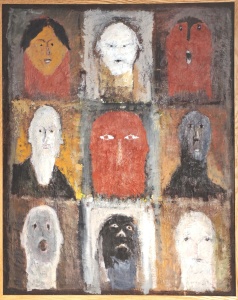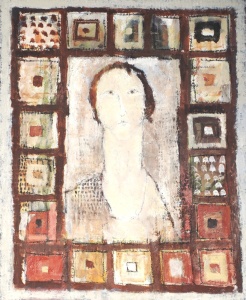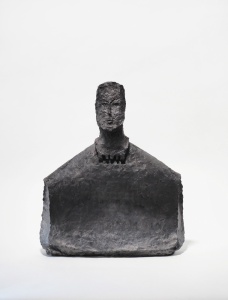Keiji Ito’s studio filmed on November 7, 2023 by Ryohei Nakajima
Tomio Koyama Gallery is pleased to present “Keiji Ito: Pictures and Ceramic Sculptures,” the artist’s second solo exhibition at the gallery.
Keiji Ito, who is currently 88 years of age, freely traverses different genres in his practice to produce an eclectic oeuvre that encompasses ceramic sculptures, oil paintings, watercolors, and collage works of thread on fabric. Always challenging new forms of expression and continuing to enthusiastically engage in his artistic practice, Ito has served as a guideline and paragon for many young artists.
In the exhibition “Keiji Ito and the artists who felt his influence,” held at the Rakusuitei Museum from June to August this year in 2023, he presented his works together with leading contemporary artists such as Takuro Kuwata, Akio Niisato, and Kentaro Kawabata, and received significant acclaim. His work is also featured in Savoir & Faire: La Terre (Iwanami Shoten), edited by the Hermes Foundation, published in August this year.
This exhibition explores the “nature of human existence”—a theme which Ito has continued to express through his depictions of human faces, figures, and movements, presenting a selection of paintings that serve as the origins of his work, as well as ceramic sculptures, which have established his reputation as an artist.
【People and Houses Depicted through Painting and Ceramic Sculptures: A Practice Rooted in Life, and a Perspective of Everyday Awareness】
Keiji Ito was born in Toki, Gifu Prefecture, a city famous for its production of pottery, and attended Musashino Art University where he studied oil painting under the likes of Yoshio Mori and Saburo Aso. Thereafter, he joined the design department of the Gifu Prefectural Ceramics Research Institute, and during his time there was greatly influenced by Sakuzo Hineno, who was a leading figure in Japan’s crafts movement. He subsequently also began to engage in the production of ceramics himself.
As can be seen from his background and personal history, for Ito, the production of paintings and ceramics are inseparable, with each influencing and supporting the other. Ito built his own wood-fired kiln in his studio, and when he was 70 years old, he also set up a painting studio in his home. Painting in times of cold and working with clay during the warmer months, he works in correspondence to the changing seasons, and mentions how the development of a painting from a ceramic sculpture can at times yield unexpected results.
What is distinctive about the works presented on this occasion is that they depict the shape of human figures and houses.
The figures are a part of the “Face” series, and their expressions are somewhat shaped by things that had inspired the artist in his youth, such as the Buddhist statues in Nara and the masks used in Noh theater. They appear to convey the mystery of how thin lines to represent eyes, nose, and mouth can give the impression of a person’s face, as well as the timelessness of human presence.
The houses are at once reminiscent of traditional pit-houses and contemporary buildings, and with their sharp and delicate contours, permeate with a sense of rich profoundness.
In every age and place, there is a persisting relationship between people and houses, which manifests in a wide variety of forms. It reminds us of the relationship and nature of “people and houses” that we take for granted and tend to forget, as well as the humble and loving perspective of the “home” as a place that shelters and protects us from nature.
【Keiji Ito’s Delicate and Free Philosophy: Fundamentals of Art and a Pioneering Spirit】
Ito stresses the importance of drawing, which is unusual for a ceramic artist. When producing ceramics, he first sketches his work on a flat surface and then transforms it into three-dimension, at times creating miniatures depending on the size. He is also sensitive to the relationship between the space and the artworks, and thus personally devises the layout for his exhibitions.
Ito states, “In my mind, there is no cross-boundary between ceramics and canvas.” As reflected in these words, his free philosophy as an artist unbound by genre, is truly remarkable. Painters in recent years have often attempted to express themselves through ceramics in contemporary art, and Ito can indeed be regarded as a pioneer in crossing such boundaries.
“I feel that ceramics, as a material, is becoming what which can be applied to other fields of expression. The use of ceramics in contemporary art is perhaps one example of this.”
(Keiji Ito, interview, Chunichi Shimbun, January 2022)
In painting, a single line may remain on the canvas until the end, yet in the case of ceramics, the outcome is ultimately entrusted to the fire. Nevertheless, what is also observed in his work is a painterly approach, such as applying pigment to the fired clay surface and wiping it off to bring out the color and texture of the clay. The artist considers the characteristics of each material to create precise and immaculate forms, all the while embracing the joys of the production process. The “world of Keiji Ito’s work” is thus something that is created through his vast and boundless perspective.
Despite having already earned a solid reputation, Keiji Ito wishes not to seek stability, but instead constantly continues to explore new paths. We welcome visitors to take this opportunity to witness the progress of his on-going explorative endeavor.
—————————————————————————————–
For press inquiries, please contact: press@tomiokoyamagallery.com
—————————————————————————————–















